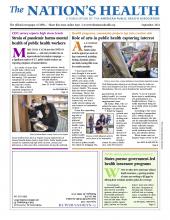
Hispanics on average live longer than other groups in the U.S., but the COVID-19 pandemic threatens that longevity.
Photo by Julio Rivalta, courtesy iStockphoto
The COVID-19 pandemic has taken a devastating toll on U.S. Hispanics, with their average life expectancy dropping by over three years, according to recent research.
The decline is striking because overall U.S. Hispanics tend to live longer than whites, Blacks and Asians. Unfortunately, many of the factors that add to their longevity also make Hispanics more vulnerable to COVID-19 infection.
Before the pandemic, life expectancy for U.S. Hispanics was about 81.5 years, according to the Centers for Disease Control and Prevention. For whites and Asians, life expectancy was around 79 years, and for Blacks it was around 76 years. Those numbers have fallen considerably during the pandemic, however.
A June study in JAMA Network Open examined COVID-19 deaths for whites, Blacks and Latinos gathered by federal agencies between February and October 2020. After separating deaths by race and ethnicity, researchers found that the Hispanic population had the largest life expectancy decline, from 81.83 years in 2018 to 78.8 years in 2020. Life expectancy for Blacks fell almost two years, and whites fell less than one year.
To explain the decline among U.S. Hispanics, researchers point to social and economic inequities that place them at high risk for COVID-19 exposure. Hispanic people have lower rates of health insurance than Black and white populations, they said, and are more likely to live in multi-generational households, where infectious diseases can spread more easily. Employment further raises risk, as Hispanics commonly work frontline jobs that require public interaction or working in groups. Language and cultural barriers can limit their ability to receive trusted information on COVID-19 safety protocols.
But even before the pandemic, life expectancy for Hispanics was in decline in some parts of the U.S. A Health Affairs study published in June estimated that Hispanics and American Indians and Alaska Natives living in U.S. counties along the Mexico border will lose two years of life expectancy compared to those populations in the rest of the U.S.
Heide Castantildeeda, PhD, an associate professor of anthropology at the University of South Florida who studies immigrant families, said that along with other social and economic factors, lack of health care and suspicion of U.S. institutions has contributed to Hispanic disparities on the border.
“This is an underserved medical landscape,” Castantildeeda, who was not involved in the Health Affairs study, told The Nation’s Health. “There are not enough primary care facilities and not enough hospitals.”
On the border in South Texas, for example, “there are a lot of veterans returning home, but there are no VA hospitals. San Antonio’s is the closest, four hours away,” she said.
Typically a group with education, economic and health care advantages, such as whites, will outlive a disadvantaged population. But that does not hold true when it comes to Hispanics, who regularly outlive whites in the U.S. This has given rise to the so-called “Hispanic paradox.” Researchers have concluded that the paradox centers around social behaviors.
Hispanics have strong communities and often live in multigenerational households, where helping one another is a given, Castantildeeda said. And though morbidity often occurs by age 50, older people are taken care of by family members.
Hispanic subgroups such as Mexicans and Dominicans also tend not to smoke tobacco, which, given the habit’s high mortality, raises average life expectancy, said Jagdish Khubchandani, MD, PhD, MPH, a public health professor at New Mexico State University at Las Cruces. Hispanics are also relatively active, drink moderately and those who immigrate arrive in America with healthy habits, he said.
“Hispanics are living longer because of good health behaviors, the healthiest come to the U.S. and they live in communities where they have support,” Khubchandani told The Nation’s Health. “But they are still not part of the health care system in the mainstream, and when there is an epidemic or some other national emergency, they are the most infected from those same characteristics — of living in tight-knit communities and not being part of mainstream health care.”
For more information on the studies, visit www.healthaffairs.org and www.jamanetwork.com.
- Copyright The Nation’s Health, American Public Health Association









